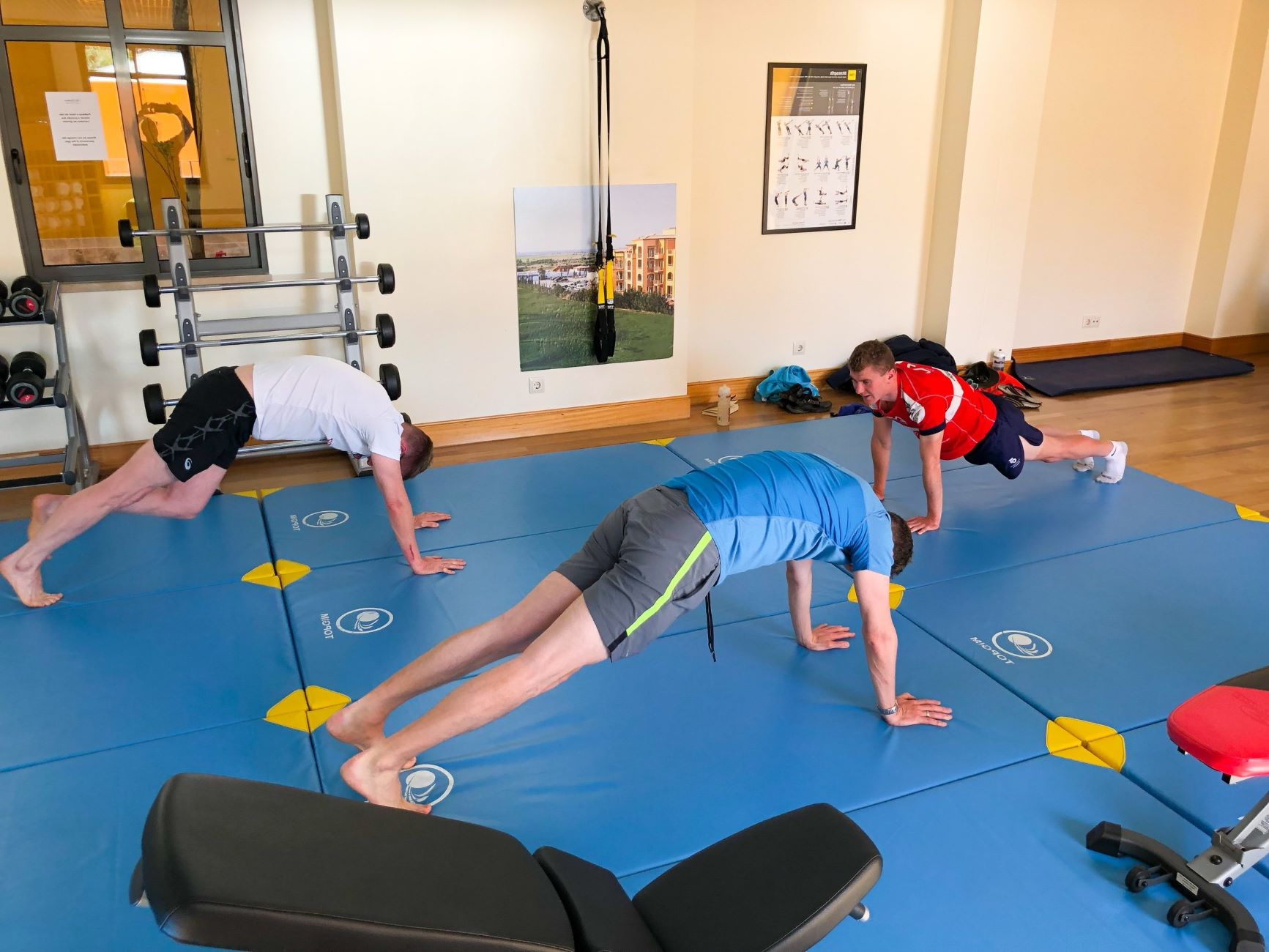Home>Training & Techniques>7 Non-Marathon Running Challenges To Take On


Training & Techniques
7 Non-Marathon Running Challenges To Take On
Published: February 29, 2024
Discover 7 non-marathon running challenges to test your training and techniques. Take on new obstacles and push your limits.
(Many of the links in this article redirect to a specific reviewed product. Your purchase of these products through affiliate links helps to generate commission for Therunningadvisor.com, at no extra cost. Learn more)
Table of Contents
- Overcoming Mental Barriers in Short-Distance Races
- Navigating Obstacles in Trail Running
- Improving Speed and Endurance in Sprint Races
- Mastering Hill Running Techniques
- Balancing Strength and Flexibility for Mid-Distance Races
- Conquering the Elements in Extreme Weather Conditions
- Developing Strategy and Tactics for Relay Races
Overcoming Mental Barriers in Short-Distance Races
Short-distance races, such as 5K or 10K runs, may seem less daunting than marathons, but they present their own set of challenges, particularly in the realm of mental fortitude. Overcoming mental barriers is crucial for success in these races, as they demand intense bursts of energy and unwavering focus. Here are some effective strategies to conquer the mental obstacles in short-distance races:
1. Visualize Success
Visualization is a powerful tool for overcoming mental barriers. Before the race, take a few moments to vividly imagine yourself crossing the finish line with strength and determination. Visualizing success can help alleviate pre-race jitters and instill confidence in your abilities.
2. Set Realistic Goals
Establishing achievable goals is essential for maintaining a positive mindset during short-distance races. Instead of fixating on a specific finishing time, focus on giving your best effort and surpassing your personal records. Setting realistic goals allows you to celebrate incremental victories and stay motivated throughout the race.
3. Embrace Discomfort
Short-distance races often involve pushing your body to its limits. Embracing discomfort and acknowledging that it is a natural part of the racing experience can help you navigate through challenging moments. By reframing discomfort as a sign of growth and progress, you can develop resilience and mental toughness.
4. Practice Mindfulness
In the midst of intense physical exertion, maintaining mental clarity is crucial. Practicing mindfulness techniques, such as deep breathing and focusing on the present moment, can help you stay grounded and centered during short-distance races. By cultivating mindfulness, you can effectively manage race-induced stress and anxiety.
Read more: The Benefits Of Taking Running Supplements
5. Positive Self-Talk
The way you speak to yourself during a race can significantly impact your performance. Engage in positive self-talk, offering words of encouragement and affirmation to yourself. Remind yourself of your training, resilience, and capabilities, reinforcing a mindset of determination and perseverance.
6. Break the Race into Segments
Dividing the race into manageable segments can prevent feelings of overwhelm and boost your mental resilience. Focus on reaching specific landmarks or milestones, rather than fixating on the entire distance. By breaking the race into smaller, achievable segments, you can maintain a sense of control and progress.
7. Reflect on Past Achievements
Drawing strength from past accomplishments can bolster your confidence and mental resilience during short-distance races. Reflect on previous races or challenging workouts where you demonstrated perseverance and determination. Reminding yourself of your ability to overcome obstacles can fuel your resolve and fortify your mental outlook.
By implementing these strategies, you can effectively overcome mental barriers in short-distance races, unlocking your full potential and achieving peak performance. Embracing the mental challenges of short-distance races not only enhances your racing experience but also cultivates a resilient mindset that extends beyond the track or trail.
Navigating Obstacles in Trail Running
Trail running presents a unique set of challenges, requiring runners to navigate rugged terrain, conquer natural obstacles, and adapt to unpredictable conditions. Unlike traditional road races, trail running demands a heightened level of agility, resilience, and strategic decision-making. To thrive in this exhilarating yet demanding environment, runners must equip themselves with the skills and mindset to overcome the obstacles encountered along the trail.
Embracing Versatility and Adaptability
One of the defining features of trail running is its dynamic and ever-changing landscape. Runners must be prepared to encounter a diverse range of obstacles, including steep inclines, rocky paths, fallen branches, and uneven terrain. Embracing versatility and adaptability is essential for navigating these obstacles effectively. By honing the ability to swiftly adjust their stride, foot placement, and pace, trail runners can maintain momentum and minimize the impact of challenging terrain.
Developing Technical Proficiency
Trail running demands a high degree of technical proficiency to surmount obstacles with confidence and efficiency. Essential skills such as proper foot placement, balance, and agility are instrumental in conquering uneven surfaces and navigating through obstacles. Additionally, mastering downhill running techniques, such as controlled descents and quick foot turnover, is crucial for maintaining speed and stability on steep declines. By dedicating time to technical training and skill development, trail runners can enhance their ability to tackle obstacles with finesse.
Mental Resilience and Decision-Making
In the realm of trail running, mental resilience and sharp decision-making are indispensable assets. Negotiating obstacles amidst varying elevations and unpredictable terrain requires a resilient mindset and the ability to adapt to unforeseen challenges. Trail runners must cultivate mental fortitude to confront obstacles head-on, viewing them as opportunities for growth rather than impediments. Moreover, making split-second decisions regarding route selection, foot placement, and navigation is pivotal for surmounting obstacles efficiently and safely.
Equipment and Gear Considerations
The selection of appropriate equipment and gear significantly influences a trail runner's ability to navigate obstacles with confidence. Sturdy trail running shoes with reliable traction and ankle support are essential for traversing uneven terrain and maintaining stability on rocky surfaces. Additionally, lightweight yet durable apparel that provides freedom of movement and protection from environmental elements is crucial for unhindered navigation through obstacles. Carrying essential gear such as hydration packs, energy snacks, and navigation tools further enhances a runner's preparedness for overcoming obstacles during trail runs.
Environmental Awareness and Respect
Trail runners must cultivate a deep sense of environmental awareness and respect for the natural surroundings in which they run. Navigating obstacles in trail running involves traversing through ecosystems that require preservation and conservation. Upholding responsible trail etiquette, such as staying on designated paths, minimizing impact on vegetation, and respecting wildlife habitats, is paramount for preserving the integrity of trail environments. By fostering a harmonious relationship with nature, trail runners can navigate obstacles while upholding environmental stewardship.
Continuous Learning and Adaptation
The dynamic nature of trail running necessitates a commitment to continuous learning and adaptation. Each trail presents its own set of obstacles and challenges, offering valuable opportunities for growth and skill refinement. By approaching each run as a learning experience and embracing the lessons derived from navigating obstacles, trail runners can continuously evolve and enhance their proficiency in conquering diverse terrains.
Embracing the Adventure
Ultimately, navigating obstacles in trail running is an adventure that beckons runners to embrace the thrill of the unknown and the exhilaration of conquering nature's challenges. By cultivating versatility, technical proficiency, mental resilience, environmental awareness, and a spirit of continuous learning, trail runners can navigate obstacles with confidence, grace, and a profound appreciation for the awe-inspiring landscapes they traverse.
In the realm of trail running, the journey is as enriching as the destination, and the obstacles encountered along the way serve as catalysts for personal growth and unparalleled adventure.
Improving Speed and Endurance in Sprint Races
Sprint races demand an exceptional blend of explosive speed and unwavering endurance, making them a thrilling yet formidable challenge for runners. To excel in sprint races, athletes must cultivate a comprehensive approach to enhancing their speed, power, and stamina. By integrating targeted training techniques, strategic conditioning, and mental fortitude, runners can elevate their performance and conquer the unique demands of sprint races.
Read more: The Most Challenging Races On Earth
Implementing High-Intensity Interval Training (HIIT)
High-Intensity Interval Training (HIIT) serves as a cornerstone for improving speed and endurance in sprint races. This structured training method involves alternating between short, intense bursts of exertion and brief periods of active recovery. By engaging in HIIT sessions, runners can enhance their anaerobic capacity, boost cardiovascular efficiency, and elevate their lactate threshold. These physiological adaptations are instrumental for sustaining high-speed efforts and surmounting the rigors of sprint races.
Focusing on Explosive Power Development
Developing explosive power is pivotal for sprinters aiming to propel themselves with maximum velocity. Plyometric exercises, such as box jumps, explosive sprints, and bounding drills, are integral for cultivating rapid force production and enhancing muscular explosiveness. By incorporating plyometric training into their regimen, runners can optimize their ability to generate swift and forceful movements, essential for sprinting with unparalleled speed and agility.
Endurance Building through Tempo Runs
While sprint races emphasize rapid acceleration and short distances, endurance remains a crucial component of overall performance. Tempo runs, characterized by sustained efforts at a challenging yet manageable pace, are instrumental for bolstering aerobic capacity and muscular endurance. By integrating tempo runs into their training routine, sprinters can fortify their ability to maintain speed over extended distances, enhancing their overall race-day performance.
Technique Refinement and Efficiency
Refining sprinting technique and biomechanical efficiency is paramount for maximizing speed and minimizing energy expenditure. Focusing on proper arm swing, stride length, and foot strike patterns can significantly enhance a sprinter's propulsion and velocity. Additionally, honing the ability to maintain relaxed yet powerful form throughout the race is essential for conserving energy and optimizing speed output.
Mental Conditioning and Race Strategy
In the realm of sprint races, mental fortitude and strategic acumen play a pivotal role in achieving peak performance. Implementing mental conditioning techniques, such as visualization, positive self-talk, and goal setting, can bolster a sprinter's confidence and resilience. Furthermore, developing a well-crafted race strategy that accounts for pacing, acceleration phases, and tactical positioning is crucial for executing a successful sprint race.
Recovery and Regeneration
Amidst the rigorous pursuit of speed and endurance, prioritizing recovery and regeneration is essential for sustaining peak performance. Adequate rest, proper nutrition, and targeted recovery modalities, such as foam rolling and mobility work, are instrumental for mitigating fatigue, preventing injuries, and optimizing physiological adaptations. By incorporating strategic recovery practices into their routine, sprinters can ensure that their bodies are primed for optimal performance on race day.
Embracing a Holistic Approach
Improving speed and endurance in sprint races necessitates a holistic approach that encompasses physical conditioning, technical refinement, mental resilience, and comprehensive recovery strategies. By integrating these multifaceted elements into their training regimen, sprinters can elevate their capabilities, surmount the unique challenges of sprint races, and achieve remarkable feats of speed and endurance.
In the pursuit of sprinting excellence, the amalgamation of targeted training, strategic preparation, and unwavering determination serves as the catalyst for transcending limitations and reaching new heights of athletic prowess.
Mastering Hill Running Techniques
Mastering hill running techniques is essential for runners seeking to conquer undulating terrain with confidence and efficiency. Hills present a unique challenge, demanding a strategic approach that encompasses both physical prowess and mental fortitude. By honing specific techniques and adopting a resilient mindset, runners can navigate uphill and downhill segments with grace, optimizing their performance and embracing the exhilarating intricacies of hill running.
Uphill Running Strategies
Ascending steep inclines requires a blend of strength, endurance, and strategic execution. Implementing the following uphill running strategies can empower runners to conquer challenging gradients with resilience and determination:
-
Maintain a Steady Cadence: Sustaining a consistent cadence while ascending hills can help runners preserve momentum and energy. Focusing on maintaining a steady rhythm of foot strikes, coupled with controlled breathing, enables runners to tackle uphill segments with greater efficiency.
-
Engage the Arms: Leveraging the power of the arms is pivotal for propelling the body uphill. Engaging the arms in a purposeful and coordinated manner, driving them in sync with each stride, can provide additional propulsion and assist in maintaining forward momentum.
-
Shorten the Stride: Adapting stride length to accommodate uphill terrain is crucial for optimizing energy expenditure. Shortening the stride and taking smaller, more frequent steps can reduce the strain on leg muscles and enhance stability, enabling runners to navigate steep inclines with greater ease.
-
Maintain an Upright Posture: Upholding an upright posture while ascending hills promotes efficient breathing and optimal biomechanical alignment. By keeping the torso upright and the chest open, runners can facilitate unrestricted airflow and minimize the impact of uphill exertion on the body.
Downhill Running Techniques
Descending steep slopes demands agility, control, and technical finesse to mitigate the impact of gravity and maintain stability. Employing the following downhill running techniques can empower runners to navigate descents with confidence and poise:
-
Controlled Foot Placement: Mindful foot placement is essential for navigating downhill terrain safely and efficiently. Landing with a midfoot or forefoot strike, as opposed to a heel strike, can enhance stability and reduce the risk of slipping or losing control on uneven surfaces.
-
Lean Forward with Control: Leaning slightly forward while descending hills can facilitate forward momentum, but it is crucial to maintain control and avoid excessive leaning. By leaning forward from the ankles with a controlled posture, runners can harness gravity to their advantage while minimizing the risk of overstraining the lower body.
-
Quick Turnover and Cadence: Embracing a quick turnover and maintaining a brisk cadence aids in managing downhill speed and reducing impact forces. Allowing the legs to move swiftly and rhythmically, while avoiding overstriding, promotes fluidity and agility during downhill running.
-
Engage Core Stability: Activating core muscles to provide stability and balance is instrumental for navigating downhill segments. Engaging the core, along with maintaining a strong and stable upper body, assists in controlling the descent and mitigating the impact of downhill running on the body.
Mental Resilience and Adaptation
Mastering hill running techniques extends beyond physical execution; it encompasses mental resilience and adaptability. Embracing a positive and determined mindset, viewing hills as opportunities for growth rather than obstacles, empowers runners to conquer the psychological challenges associated with undulating terrain. By cultivating mental fortitude and adaptability, runners can approach hills with confidence, tenacity, and an unwavering spirit, transcending the inherent difficulties of hill running.
In essence, mastering hill running techniques involves a harmonious fusion of physical prowess, technical proficiency, and mental resilience. By integrating these elements into their training and race strategies, runners can navigate undulating terrain with finesse, embracing the dynamic intricacies of hill running as a testament to their strength, agility, and unwavering determination.
Balancing Strength and Flexibility for Mid-Distance Races
Achieving optimal performance in mid-distance races necessitates a harmonious equilibrium between strength and flexibility, as these attributes are pivotal for enhancing speed, endurance, and overall race-day prowess. The unique demands of mid-distance races, spanning distances such as 800 meters to 5 kilometers, require runners to cultivate a multifaceted approach that integrates muscular strength, suppleness, and dynamic mobility. By striking a delicate balance between strength and flexibility, runners can fortify their physical capabilities, mitigate the risk of injuries, and elevate their performance in mid-distance events.
Strength Training for Mid-Distance Races
Integrating targeted strength training into a runner's regimen is instrumental for fortifying the musculature essential for mid-distance races. Emphasizing the following aspects of strength training can empower runners to optimize their physical resilience and performance:
-
Lower Body Strength: Prioritizing exercises that target the lower body, such as squats, lunges, and calf raises, enhances muscular power and endurance. Strengthening the quadriceps, hamstrings, and calf muscles is pivotal for generating propulsive force and sustaining speed throughout mid-distance races.
-
Core Stability: Cultivating core strength through exercises like planks, Russian twists, and leg raises fosters stability and alignment, essential for maintaining efficient running mechanics and minimizing energy wastage.
-
Functional Movements: Incorporating functional movements that mimic the biomechanics of running, such as single-leg deadlifts and lateral lunges, bolsters muscular coordination and balance, contributing to enhanced running economy and agility.
Flexibility and Dynamic Mobility
In tandem with strength training, prioritizing flexibility and dynamic mobility is paramount for mid-distance runners aiming to optimize their range of motion, prevent muscular tightness, and facilitate fluid, efficient running mechanics. Key elements of flexibility and mobility enhancement include:
-
Dynamic Stretching: Engaging in dynamic stretching routines, encompassing leg swings, hip circles, and walking lunges, primes the muscles for dynamic movement and promotes optimal joint mobility, crucial for mid-distance running performance.
-
Foam Rolling and Myofascial Release: Incorporating foam rolling and myofascial release techniques aids in alleviating muscular tension, enhancing circulation, and promoting tissue suppleness, contributing to enhanced running fluidity and reduced injury risk.
-
Yoga and Pilates: Integrating yoga and Pilates sessions into a training regimen fosters comprehensive flexibility, balance, and body awareness, complementing the muscular demands of mid-distance races with a holistic approach to physical conditioning.
The Synergistic Balance
Balancing strength and flexibility for mid-distance races entails a synergistic interplay between muscular power and pliability, culminating in a harmonious fusion of physical attributes that optimize running performance. By cultivating robust lower body strength, core stability, and functional mobility, while concurrently prioritizing flexibility, dynamic stretching, and tissue suppleness, runners can harness a comprehensive foundation that empowers them to excel in mid-distance events.
In essence, the pursuit of a balanced approach to strength and flexibility for mid-distance races serves as a testament to a runner's commitment to holistic physical conditioning, resilience, and unwavering dedication to achieving peak performance. By embracing this equilibrium, runners can transcend limitations, elevate their capabilities, and navigate the dynamic challenges of mid-distance races with grace, tenacity, and unparalleled athletic prowess.
Conquering the Elements in Extreme Weather Conditions
Confronting extreme weather conditions is a formidable challenge that demands strategic preparation, adaptability, and unwavering resilience from runners. Whether facing scorching heat, frigid cold, torrential rain, or gusting winds, the ability to conquer the elements is pivotal for maintaining performance, ensuring safety, and achieving success in races. By implementing comprehensive strategies tailored to specific weather challenges, runners can navigate the adversities posed by extreme conditions with fortitude and determination.
Read more: Maximize Your Run Commute With These 7 Tips
Heat and Humidity
Enduring sweltering heat and oppressive humidity necessitates meticulous planning and proactive measures to mitigate the impact of high temperatures on the body. Strategies for conquering extreme heat include:
-
Hydration Management: Prioritizing hydration before, during, and after runs is crucial for combating dehydration and heat-related illnesses. Carrying water or electrolyte-replenishing fluids during races is essential for sustaining optimal performance in hot conditions.
-
Heat Acclimatization: Gradual exposure to heat and humidity conditions enables the body to adapt and enhance its thermoregulatory mechanisms. Acclimatization training, conducted in progressively warmer environments, prepares runners to withstand extreme heat with greater resilience.
-
Apparel Selection: Opting for lightweight, breathable, and moisture-wicking apparel facilitates effective heat dissipation and minimizes discomfort caused by excessive sweating. Sun-protective clothing and accessories offer additional defense against the sun's intense rays.
Cold and Inclement Weather
Navigating frigid temperatures, icy surfaces, and inclement weather demands a blend of preparation, insulation, and adaptability to ensure safety and performance optimization. Strategies for conquering extreme cold and inclement weather include:
-
Layering: Utilizing a layered clothing approach enables runners to regulate body temperature and retain warmth in cold conditions. Moisture-wicking base layers, insulating mid-layers, and weather-resistant outer shells provide comprehensive protection against the elements.
-
Footwear Traction: Selecting running shoes with reliable traction and grip is essential for navigating icy or slippery surfaces. Traction-enhancing devices, such as ice cleats or traction spikes, offer additional stability and safety in wintry conditions.
-
Wind Protection: Shielding the body from biting winds is crucial for preventing heat loss and maintaining comfort. Windproof and insulated outerwear, coupled with protective headwear and gloves, form a barrier against chilling gusts.
Rain and Wet Conditions
Enduring relentless rain and soggy terrain necessitates adaptability, waterproofing, and mental fortitude to navigate through the challenges posed by wet weather. Strategies for conquering extreme rain and wet conditions include:
-
Waterproof Gear: Investing in waterproof or water-resistant apparel and accessories, including jackets, pants, and hats, shields runners from the soaking effects of rain and minimizes discomfort caused by wet clothing.
-
Footwear Drainage: Selecting running shoes with efficient drainage capabilities prevents water accumulation and maintains foot comfort in wet conditions. Quick-drying and breathable footwear options are instrumental for minimizing the impact of rain-soaked terrain.
-
Visibility and Safety: Incorporating reflective and high-visibility elements into running attire enhances visibility in low-light, rainy conditions, promoting safety and awareness amidst reduced visibility.
By embracing these tailored strategies and fortifying their mental resolve, runners can conquer the elements in extreme weather conditions, transcending the adversities posed by heat, cold, rain, and inclement weather. The ability to adapt, prepare, and persevere in the face of extreme conditions exemplifies a runner's indomitable spirit and unwavering commitment to conquering the elements, regardless of the challenges presented by Mother Nature.
Developing Strategy and Tactics for Relay Races
Relay races demand meticulous planning, seamless coordination, and strategic execution to optimize team performance and achieve competitive success. Developing a comprehensive strategy and employing effective tactics are pivotal for navigating the intricacies of relay events, where seamless baton exchanges, strategic positioning, and synchronized efforts are paramount. By honing strategic acumen and tactical proficiency, relay teams can maximize their collective potential and elevate their performance in these exhilarating and dynamic races.
Pre-Race Planning and Coordination
Pre-race planning serves as the foundation for a successful relay race, encompassing critical elements such as team composition, leg assignments, and baton exchange strategies. Coordinating with team members to determine individual strengths and optimal leg assignments is essential for capitalizing on each runner's capabilities. Additionally, establishing clear communication channels and refining baton exchange techniques through synchronized practice sessions fosters seamless transitions and minimizes the risk of disqualification due to faulty exchanges.
Strategic Positioning and Transitions
Strategic positioning during relay races involves astute decision-making regarding lane selection, acceleration zones, and transition points. Identifying optimal positions for each runner based on their strengths, such as utilizing a strong curve runner for the second leg, can provide a strategic advantage. Moreover, mastering the art of smooth and efficient baton exchanges, including the use of acceleration zones to build momentum before the exchange, is instrumental for maintaining speed and minimizing time losses during transitions.
Pacing and Energy Distribution
Striking a balance between aggressive pacing and energy distribution is crucial for optimizing performance across multiple relay legs. Implementing a pacing strategy that accounts for the varying distances and individual capabilities of each team member is essential for sustaining momentum throughout the race. Moreover, emphasizing efficient energy distribution and strategic surges in acceleration can propel the team towards a competitive edge while conserving energy for subsequent legs.
Adaptability and Contingency Planning
Relay races often unfold amidst dynamic and unpredictable circumstances, necessitating adaptability and contingency planning. Developing contingency strategies to address potential disruptions, such as unexpected weather changes or tactical adjustments by rival teams, empowers relay squads to navigate unforeseen challenges with resilience and strategic agility. Embracing adaptability and remaining poised in the face of unexpected developments is pivotal for maintaining a competitive edge throughout the race.
Team Cohesion and Support
Fostering a cohesive and supportive team dynamic is integral for enhancing morale, camaraderie, and collective motivation during relay races. Encouraging open communication, providing mutual support, and fostering a shared sense of purpose among team members cultivates a resilient and unified team ethos. This cohesive synergy not only bolsters team morale but also enhances the overall performance and competitive spirit of the relay squad.
In essence, developing a comprehensive strategy and employing effective tactics for relay races is a multifaceted endeavor that encompasses meticulous planning, strategic positioning, adaptability, and cohesive teamwork. By honing these strategic and tactical elements, relay teams can harness their collective potential, navigate the complexities of relay events, and strive towards achieving remarkable feats of athletic prowess and collaborative achievement.






